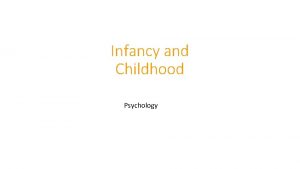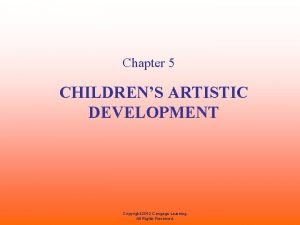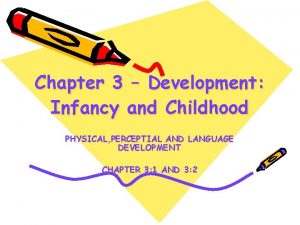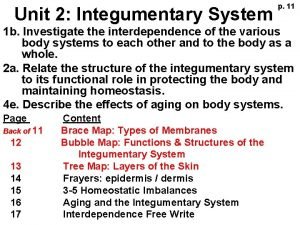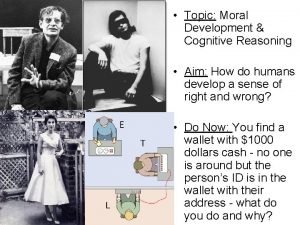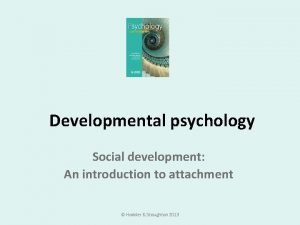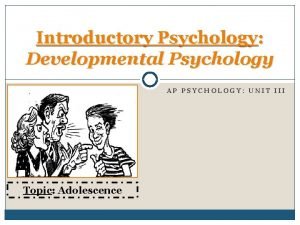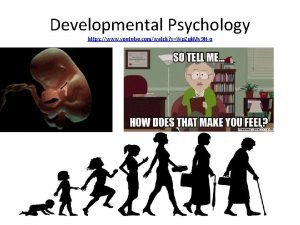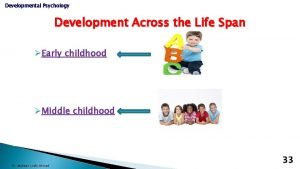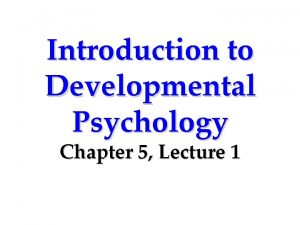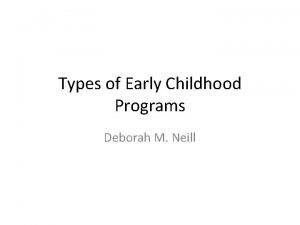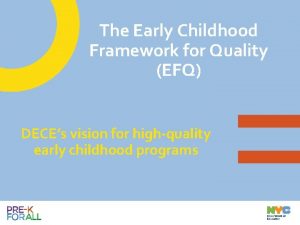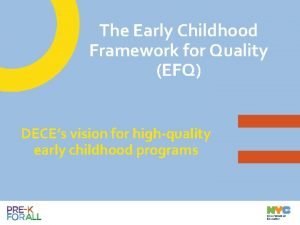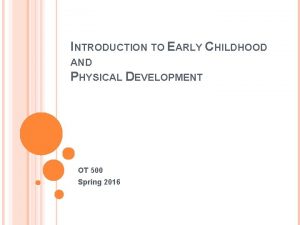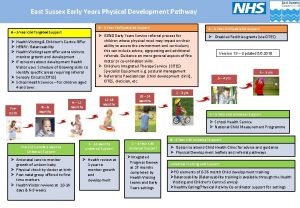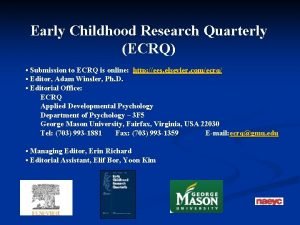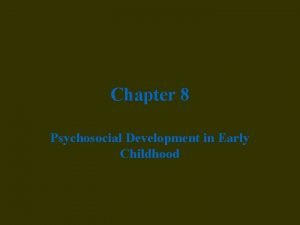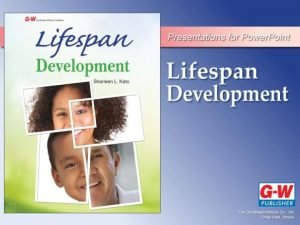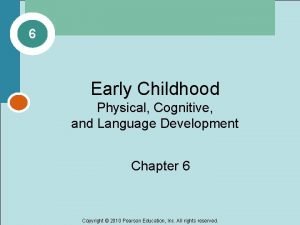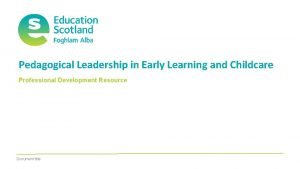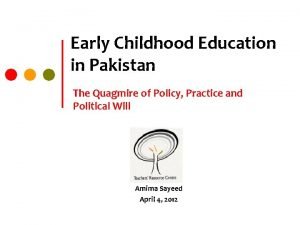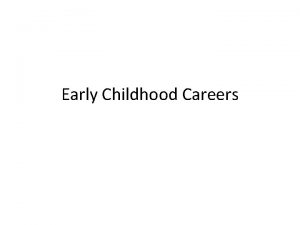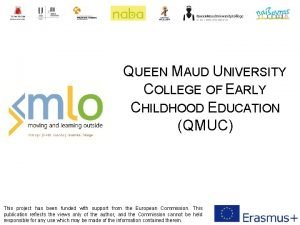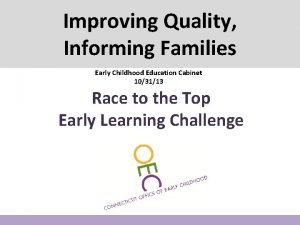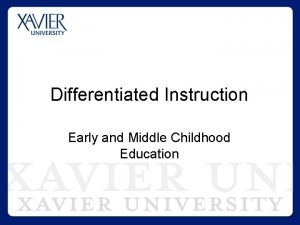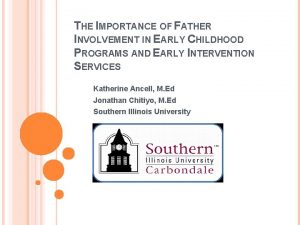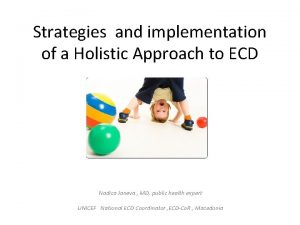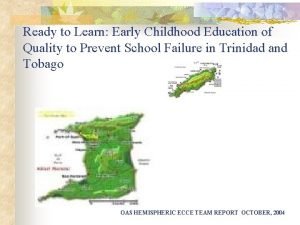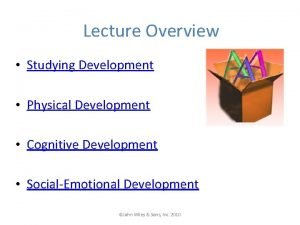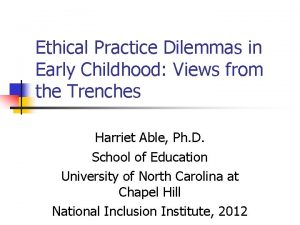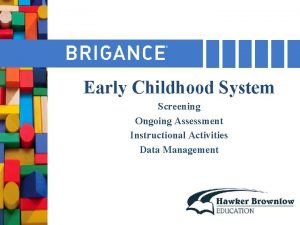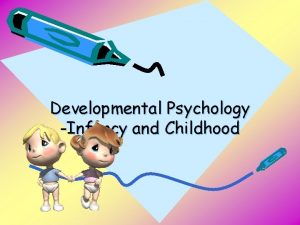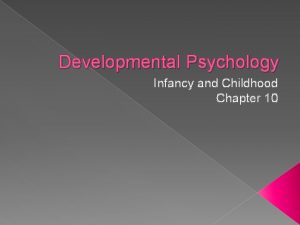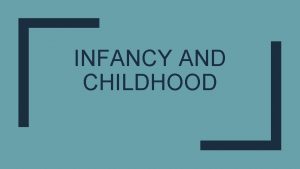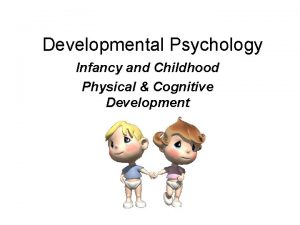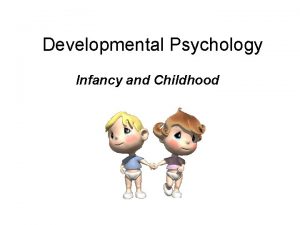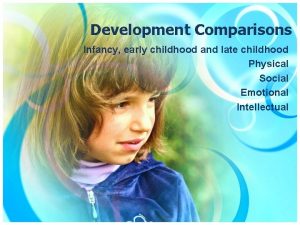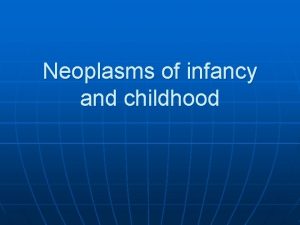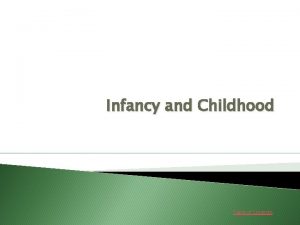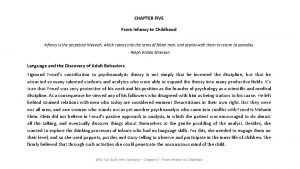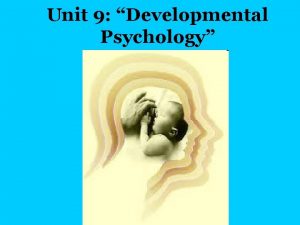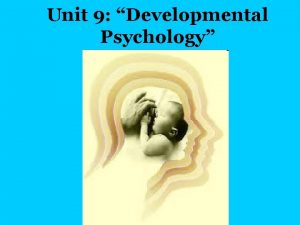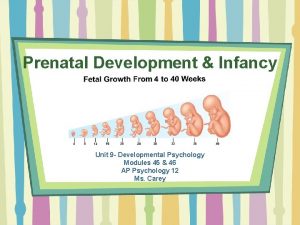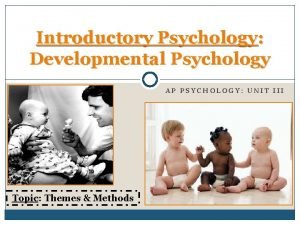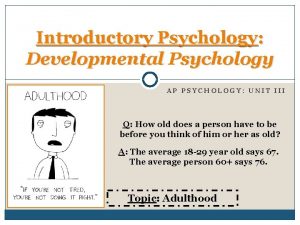Infancy and Early Childhood Unit 3 Developmental Psychology







































































- Slides: 71

Infancy and Early Childhood Unit 3: Developmental Psychology

Overview 1. Infancy and Childhood ○ Physical, cognitive, emotional development ○ Language acquisition ○ Parenting styles and attachment ○ Social development 2. Adolescence ○ Physical and sexual development ○ Personal, social and moral development

Developmental Psychology The specialized study of how an individual’s physical, social, emotional, moral, and intellectual development occur in sequential, interrelated stages throughout the life cycle. Developmental Psychologists study 3 main issues: 1. Continuity and Stages of Development 2. Stability vs. Change 3. Nature vs. Nurture

Infancy and Early Childhood

Infant Physical Development Infants on average weight 7. 3 pounds at birth and are between 18 -22 inches long. Unless a child is underfed, severely restricted in his/her movements, or deprived of human contact and stimulation he/she will develop more or less according to a typical schedule of maturation. Maturation: Internally programmed growth that all children go through.

Milestones in Physical Maturation

Newborns At birth, the newborn is capable of certain inherited, automatic, coordinated movement patterns called reflexes, that can be stimulated by the right stimulus. Doctors use reflexes to determine the health of infants. Absent reflexes or those that persist beyond the normal age can be signs of damage to the CNS or brain. https: //www. youtube. com/watch? v=0 V 4 x 0 i. QODTk

Reflex Research For the reflexes listed you must gather the following information: 1. Name of reflex 2. Description 3. Purpose (if any) 4. Duration (when it starts and when it should disappear) Use the chart to record the data you find. Ensure you are using credible sources.

Reflexes Recap Reflexes: Inherited, automatic, coordinated movement patterns that newborns are born with and that can be triggered by the right stimulus. ● Some are linked to survival ex) Rooting Reflex ● Others are used as signs of normal development ex) Babinski Reflex

Development of Language and thought are closely intertwined. Both use symbols to represent objects and they go hand-in-hand when it comes to cognitive development. No other species on the planet uses language, as humans do, to communicate an infinite number of ideas (sentences) with a limited set of symbols (speech sounds and words). Crash Course: https: //www. youtube. com/watch? v=s 9 sh. Pou. RWCs&index=16&list=PL 8 d. Puua. Lj. Xt. OPRKz. VLY 0 j. JY-u. HOH 9 KVU 6

During the game you can only speak with your groups’ phonemes. Learning Language Activity Your goal is to form a language using a limited list of phonemes. During “time outs” you may speak English but may not discuss the game with group mates. You can take notes (in English) At the end each group will showcase their language with a group activity.

Language Game Reflection 1. Define phonemes. 1. The Whole Object Constraint occurs when someone makes an assumption that a novel word refers to the entire object rather than a part or quality of that object. Give an example from yesterday’s activity. 1. What is the difference between over-extension and under-extension?

Language Game Reflection 1. Define phonemes. Basic units of sound in language such as the “ch” sound in chug. 1. The Whole Object Constraint occurs when someone makes an assumption that a novel word refers to the entire object rather than a part or quality of that object. Give an example from yesterday’s activity. ex) Thinking “oot” meant triangle when it was supposed to refer to the colour.

Language Game Reflection 1. What is the difference between over-extension and under-extension? Over-Extension ● Using a word to refer to more than its intended referent. ex) “Ball” to refer to balloons, eggs, and marbles. Under-Extension ● Using a word to refer to less than its intended referent. ex) only soccer balls are “Ball” but not basketballs or volleyballs.

Structure of Language 1. Phonemes: The smallest distinguishable units of language. ex) Puh, Mmm, Ahh, Eee, Ooo 1. Morphemes: The smallest meaningful units of language. ex) The word disliked has 3 morphemes - “dis”, “like”, and “ed” 1. Grammar: The system of rules that governs how words and sounds can be meaningfully arranged to form sentences. ex) One rule of syntax is that an article such as “the” must come before a noun, not after: “Read the book, ” not “Read book the. ”

Stages of Language Acquisition 1. Prelinguistic Sounds ○ Cooing Stage ■ crying, cooing, gurgling ■ Birth - 4 months ○ Babbling Stage ■ sounds and environmental responses ■ 5 - 12 months 2. One-Word Stage ○ Sounds used as symbols

Stages of Language Acquisition 1. Telegraphic Speech ○ two and three word expressions ○ begin to show awareness of basic linguistic rules ○ 18 - 24 months 2. Speech using Grammar ○ longer sentences with more elaborate syntax ○ learning 20 - 30 words per day ○ 2 - 3 years 3. Adultlike Speech

Early Theories Skinner (1957) - As one of the pioneers of behaviourism, he believed language acquisition occurred as a result of environmental influence. - Argued that children learn language based on the positive or negative reinforcement they receive after utterances. Ex) A child says “milk” and the mother smiles and gives her some.

Universal Grammar Noam Chomsky (1950’s) - Criticizes Skinner’s theory heavily, believing the process would be too slow to allow children to acquire the infinite sentences we use in language. - He proposed theory of Universal Grammar: an idea that children possess an innate knowledge of the grammatical principles that govern language. - Implied that all the world’s languages have common structural rules called general principles. - Each language then has its own specific parameters that dictate the variability in syntax.

Zone of Proximal Development Lev Vygotsky - Focused on social learning and the zone of proximal development (ZPD) a. The amount of learning a child can accomplish with guidance from others. The difference between what they can do on their own, and what they cannot do. - Language is obtained when children engage in social interactions with others. - Designated 3 types of speech: a. Social speech (out loud, to others) b. Private speech (out loud, to oneself) c. Inner speech (silent, thoughts to oneself)

Critical Period Hypothesis Eric Lenneberg - Believed that the ability to acquire language is subject to critical periods - limited spans of time during which a person is sensitive to external stimuli and capable of acquiring certain skills - Proposed a critical period for language acquisition from age 2 to around age 12 (before puberty) - After the onset of puberty, based on the structure and organization of the brain, one cannot learn and utilize language in a fully functional manner. Ex) The Case of Genie (1970)

Cognitive Development

Jean Piaget Who is he? ● Swiss psychologist ● Studied cognitive development in children ● Used his daughter for much of his research What did he do? ● Stressed the active role of the child in gaining knowledge. ● Developed a stage theory for the cognitive development of children from birth to the onset of puberty.

How Knowing Changes Each of us constructs schemas, applying them and changing them as needed. We try to understand new objects by relating them to one of our existing schemas. Schemas: Mental representations of the world Assimilation: The process of fitting new objects into existing schemas Accommodation: The adjustment of one’s schema to include new experiences Ex) Doggy -- Kitty Assimilation Accommodation

How Knowing Changes Assimilation and Accommodation work together to produce intellectual growth and the child begins to understand things in new ways. Along the developmental pathway there are certain markers psychologists have come to recognize that can be used to measure a child’s cognitive development. Ex) Object Permanence Representational Thought Conservation Egocentrism

Object Permanence A child’s realization that an object exists even when he or she cannot see or touch it. ● An infant’s understanding of things lies totally in the present, they cannot imagine it, remember it, or picture it in their mind. ● If you take a toy and hide it from view, it no longer exists. ● Fades around 7 -12 months.

Object Permanence This represents a huge stage in development where the child now realizes that people and objects exist apart from his/her own actions.

Representational Thought The intellectual ability of a child to picture something in his or her mind. ● The achievement of object permanence suggests that a child has begun to engage in what Piaget calls representational thought. ● Occurs at about 14 months of age ● Another example of representational thought is imitation. Ex) A child observes another child having a temper tantrum and later imitates the same behaviour, having never done it before.

Conservation The principle that a given quantity does not change when its appearance is changed. ● Begins to appear between ages 5 and 7 ● Ex) Children under 5 are unable to think about two dimensions, such as height and width, at the same time.

Egocentrism A young child’s inability to understand another person’s perspective. ● This causes many of the errors kids make in conservation. ● Lasts until about age 7 ● The “ 3 Mountains” Test is one of Piaget’s inventions to test egocentrism.

Piaget’s Stages of Cognitive Development Stage Age Characteristics Sensorimotor Birth - 2 years - Knowledge is gained through the sense and motor activity - Behaviour consists of simple responses to environmental stimuli - By the end of this stage, infants achieve sense of object permanence Pre Operational 2 - 6 years - Lacks operations (reversible mental processes) - Able to use symbols such as language, numbers and objects - Children begin to “play pretend” - Children exhibit egocentric thinking Concrete Operational 7 - 11 years - Understands and applies logical operations (ex. counting, reading) - Begin to lose egocentric focus - Still has trouble with abstract ideas and thinking Formal Operational Adolescence + - Thinks abstractly, understands hypothetical ideas - Capable of logic and deductive reasoning

Experiments with Animals Imprinting ● Konrad Lorenz discovered that some animals become attached to the first moving object they see (usually their mothers) in a rapid, virtually permanent learning process called imprinting. ● Imprinting occurs during a critical period, much like language acquisition Surrogate Mothers ● Harry Harlow studied this critical period for attachment in his famous rhesus monkey experiment. ● He attempted to discover what it was about an animal's mother that causes such

Human Infants Many psychologists have seeked to answer the question of whether or not there is a critical period when human infants need to become attached to a caregiver. ● Infants begin to form an attachment to their mothers at about 6 months, once they are able to distinguish one person from another. ● This attachment remains strong between the ages of 6 months and 3 years. ● By 3 years an infant has achieved the ability to represent their mothers in thought and can maintain attachment even when she is absent.

Mary Ainsworth and her partner, John Bowlby, studied attachment between mothers and children using the Strange Situation experiment. Based on this research she found three patterns of attachment and other psychologists have since added a fourth: 1. Secure Attachment 2. Avoidant Attachment 3. Resistant Attachment 4. Disorganized Attachment https: //www. youtube. com/watch? v=QTsew. Nr. HUHU

Characteristics of Attachment Styles Secure Attachment (70%) Avoidant Attachment (15%) Resistant Attachment (15%) Separation Anxiety Distressed Intense distress No sign of distress Stranger Anxiety Avoidant of stranger when alone, but friendly when mother present Avoids the stranger, may show fear of stranger Ok with the stranger, plays normally when they are present Reunion Behaviour Positive and happy when mother returns Child approaches mother, but resists contact, may push her away Infant shows little interest when mother returns

Parenting Styles

Parenting Styles The way children seek independence and the ease with which they resolve conflicts depends in large part on the parent-child relationship. Diana Baumrind (1971) observed and interviewed nursery school children and their parents. Follow-up observations were conducted when the children were 8 or 9 years old. Her observations led to conclusions about the impact 3 distinct parenting styles on children: authoritarian, democratic, and permissive.

Read pg. 78 -80 Parenting Styles From the section you read identify the effects of each parenting styleand record them on looseleaf. ex) Democratic Authoritarian Permissive -

Authoritarian ● In authoritarian families parents are the bosses. ● They do not believe they have to explain their actions or demands. ● Parents may believe children have no right to question parental decisions.

Democratic ● In democratic families children participate in decisions affecting their lives. ● There is a great deal of discussion and negotiation. ● Parents listen to their children’s reasons for wanting to do something and make an effort to explain their rules and expectations. ● The children make many decisions for themselves but the parents retain the right to veto plans of which they disapprove.

Permissive ● In permissive families children have the final say. ● The parents may attempt to guide the children but give in when the children insist on having it their own way. ● The parents may simply give-up their child-rearing responsibilities - setting no rules about behaviour, making no demands, voicing no expectations, virtually ignoring the children in their house.

Effects of Parenting Styles Studies suggest that children who grow up in authoritative or democratic families are more confident of their own values and goals than other young people. This seems to come from two features: ● The establishment of limits on the child ● Responding to the child with warmth and support

Effects of Parenting Styles There are several reasons for this confidence in themselves ● The child is able to assume responsibility gradually ○ Not denied the opportunity to use judgement ○ Not given too much responsibility too soon ● The child is more likely to identify with parents who demonstrate love and respect as opposed to those who treat the child as incompetent or who seem indifferent ● Finally, through their behaviour toward the child democratic parents present a model of responsible cooperative independence for the child to imitate.

Social Development

Social Development Socialization is the process of learning the rules of behaviour of the culture within which an individual is born and will live. ● Some social rules are clear and inflexible while others leave room for individual decisions. ● Every society has ideas about what is meaningful, valuable, beautiful. ● Every society classifies people according to their family, sex, age, skills, personality characteristics, and other criteria. ● Involves learning to live with other people and with yourself.

Freud’s Theory of Psychosexual Development Freud believed that personality develops through a series of childhood stages in which the pleasure-seeking id become focused on certain erogenous areas. ○ Id - primitive, instinctual motives to satisfy basic needs and desires ○ Ego - largely conscious, realistic part of our personality that mediates the needs of the id in socially acceptable ways. ○ Superego - source of conscience in personality, counteracts the id. Psychosexual energy, or libido is the driving force behind behaviour. If a person fails to progress fully through a stage fixation can occur. Fixation - persistent focus on an earlier psychosexual stage.

Freud’s Theory of Psychosexual Development 1. Oral Stage (birth-1 year) Description The infant’s primary source of stimulation is through the mouth (rooting and sucking reflexes). The mouth is vital for eating and the infant derives pleasure from oral stimulation. The infant is dependent on caretakers and develops sense of trust and comfort in this stage. Erogenous Zone Mouth Primary Conflict Weaning the child from nursing - child must become less dependent Fixation Results in dependency or aggression. May develop problems with drinking, eating, smoking, or nail biting.

Freud’s Theory of Psychosexual Development 2. Anal Stage (1 -3 years) Description Primary focus of the libido is on controlling the bladder and bowel movements. Developing control of these processes leads to a sense of accomplishment and independence. Success may depend on the way in which parents toilet train. Children benefit from support and encouragement from parents. Erogenous Zone Bowel and Bladder Primary Conflict Toilet training (controlling bodily needs) Fixation Results in either: - anal-expulsive personality if parents are too lenient (messy, wasteful, or destructive). - anal-retentive personality if parents are too strict ( stringent, orderly, rigid, and obsessive).

Freud’s Theory of Psychosexual Development 3. Phallic Stage (3 -6 years) Description The primary focus of the libido is on the genitals. At this age children begin to discover the differences between males and females. Freud also believed that boys begin to view their fathers as a rival for the mother’s affections. Eventually the child begins to identify with the same-sex parent. Erogenous Zone Genetals Primary Conflict Unconscious desire to possess the opposite-sexed parent and to eliminate the same-sexed one. - Oedipus Complex in boys - Electra Complex in girls Fixation Results in recklessness, self-assuredness and narcissism -- excessive vanity and pride. May also result in the inability to form close, loving relationships.

Freud’s Theory of Psychosexual Development 4. Latent Period (6 years - puberty) Description During the latent period the libido interests are suppressed due to the development of the ego and superego. A time of exploration during which the child’s energy is directed into other areas such as intellectual pursuits and social interactions. Erogenous Zone Sexual feelings are inactive Primary Conflict None Fixation None - but the latent period is an important time for development of social and communication skills and self-confidence.

Freud’s Theory of Psychosexual Development 5. Genital Stage (puberty +) Description During this final stage, the individual develops strong sexual interests in members of the opposite sex. Interest in the welfare of others grows during this stage. If the other stages have been completed successfully, the individual should now be wellbalanced, warm, and caring. Erogenous Zone Maturing Sexual Interests Primary Conflict Resolution of any previous fixations Fixation Goal is to establish balance between the various life ares.

Evaluating Freud’s Theory Freud’s theory is still considered controversial today, imagine how it was perceived in the late 1800 s when he published it. Discuss with your table partners potential areas for criticism of Freud's theory.

Erikson’s Theory of Psychosocial Development Erikson takes a broader view of human development in both time and scope. He recognizes the sexual and aggressive urges but believes the need for social approval is just as important. He studied psychosocial development. Psychosocial development: Life periods in which an individual’s goal is to satisfy desires associated with social needs. In each stage of his theory a person faces a particular crisis or conflict that represents an issue everyone faces. Development within each stage is affected by how other people respond to his/her efforts.

Stage 1: Trust vs. Mistrust Stage Infant (birth - 18 months) Crisis Trust vs. Mistrust Description Development of trust depends on the dependability and reliability of caregivers. If care is consistent, predictable and reliable, they will develop trust they can carry to other relationships and will feel secure when threatened. Positive Outcome Child feels safe in the world Negative Outcome Child fears and believes the world is inconsistent and unpredictable Important Event Feeding

Stage 2: Autonomy vs. Shame and Doubt Stage Toddler (2 -3 years) Crisis Autonomy vs. Shame and Doubt Description The child develops a greater sense of personal control due to increased mobility and a greater awareness of their abilities and independence. Parents need to encourage the child in this independence while protecting them from constant failure. Positive Outcome The child feels secure and confident Negative Outcome The child has feelings of inadequacy and self-doubt Important Event Toilet training

Stage 3: Initiative vs. Guilt Stage Preschooler / Early Childhood (3 -5 years) Crisis Initiative vs. Guilt Description Children begin to assert their power and control over the world through directing play and social interaction. Play provides ample opportunity to develop initiative but If this tendency is squelched through criticism or control, children may develop guilt. Positive Outcome Child feels capable and able to lead others Negative Outcome Child has feelings of guilt and self-doubt, and lack of initiative Important Event Exploration

Stage 4: Industry vs. Inferiority Stage School Age (6 - 11 years) Crisis Industry (competence) vs. Inferiority Description Through social interactions, the child develops a sense of pride in their accomplishments and abilities. Peer groups become a major source of self-esteem at this stage. If the child cannot develop skills they feel society is demanding they may develop a sense of inferiority. Positive Outcome Child feels sense of competence and belief in their skills Negative Outcome The child doubts his/her ability to be successful Important Event School

Stage 5: Identity vs. Role Confusion Stage Adolescence (12 - 18 years) Crisis Identity vs. Role Confusion Description Teens are exploring their independence and developing a sense of self. This is a major stage in development where the child has to learn the roles he/she will occupy as an adult. This includes social, sexual, and occupational identity. Positive Outcome Teen has a strong sense of self, and feelings of independence and control Negative Outcome Those who remain unsure of their beliefs and desires will feel insecure and confused about themselves in the future Important Event Social Relationships

Stage 6: Intimacy vs. Isolation Stage Young Adulthood (19 - 40 years) Crisis Intimacy vs. Isolation Description In this stage, people are exploring personal relationships leading toward longer term commitments with someone other than a family member. Positive Outcome Those who succeed will develop relationships that are committed and secure Negative Outcome Those with a poor sense of self (from the previous stage) will likely have less committed relationships, and are more likely to suffer emotional isolation, loneliness and depression. Important Event Relationships

Stage 7: Generativity vs. Stagnation Stage Adulthood (40 - 65 years) Crisis Generativity vs. Stagnation Description We continue to live our lives, focussing on career and family. We give back to society by raising our children, being productive at work and involved in the community. Positive Outcome Those who succeed feel they are contributing to their world by being active in their home and community. Negative Outcome Those who fail to attain this skill will feel unproductive and uninvolved in the world. Important Event Work and Parenthood

Stage 8: Ego Integrity vs. Despair Stage Old Age (65 - death) Crisis Ego Integrity vs. Despair Description This stage is focussed on reflecting back on life. Productivity tends to slow down and we contemplate our accomplishments and are able to develop integrity if we see ourselves as leading a successful life. Positive Outcome Those who succeed look back with few regrets and a general feeling of satisfaction. Negative Outcome Those who fail feel their life has been wasted and have many regrets. They may feel bitterness and despair. Important Event Reflection on life

Worksheet

Kohlberg’s Theory of Moral Development Lawrence Kohlberg (1968) studied the development of moral reasoning - deciding what is right and wrong - by presenting children of different ages with a series of moral dilemmas. ex) The Heinz Dilemma What interested him was how children arrived at a conclusion, what sort of reasoning they used to justify their response.

What Would You Do? ? ? You are on holiday in Bali with your 18 year old son and wife. You have been there for a week and are ready to head home. All three of you are at the airport getting ready to board your plane, when an armed officer comes around with a sniffer dog. You have all your bags on a trolley, and the dog sniffs at both your wife and your bag, and passes over it, however when he gets to your sons bag, he begins to get a bit more active. You look over at your son and he’s looking a little nervous. You know he’s smoked a little marijuana in his time, but generally, he’s a good kid, and you certainly didn’t think he’d actually be stupid enough to bring it back on the plane with him. At first you feel angry that he would do such a thing and start planning your responsibility lecture, but then you realize that you are in Bali, and they have a zero tolerance policy on drugs, meaning your son could be jailed for life, or worse, executed, if he does have some illicit materials in his bag. You look at your wife and realize she has come to the same conclusion and has gone pale with fear. The armed officer accompanying the dog is beginning to look more stern with every sniff the dog takes and looks directly at you and asks you to open to the bag. You do, and as the officer begins to take things out of the bag, you see to your horror that there is a small quantity of marijuana stashed in with your sons belongings. The officer looks at you and asks “Who’s bag is this? ” You realize you have to answer, but the answer won’t be easy. You see your wife in the corner of your eye, and she is about to step forward and claim it as her own; what do you say?

What Would You Do? ? ? A madman who has threatened to explode several bombs in crowded areas has been apprehended. Unfortunately, he has already planted the bombs and they are scheduled to go off in a short time. It is possible that hundreds of people may die. The authorities cannot make him divulge the location of the bombs by conventional methods. He refuses to say anything and requests a lawyer to protect his fifth amendment right against self-incrimination. In exasperation, some high level official suggests torture. This would be illegal, of course, but the official thinks that it is nevertheless the right thing to do in this desperate situation. Do you agree? If you do, would it also be morally justifiable to torture the mad bomber’s innocent wife if that is the only way to make him talk? Why?

What Would You Do? ? ? One morning you are driving to work, and as per usual you are running a bit late, so you are driving a touch faster than the speed limit. You reach down to your stereo to change the CD, when all of a sudden your car hits something solid. You spin to a stop, but not before several more cars have run into you and each other in an attempt to avoid the accident. As you look up and out of your car, you can see that you hit a person, and that the person is not looking very good. In fact, you are sure that they are dead. You shakily get out of your car, and look around at the damage that has been caused. Several cars have been badly smashed up, but more importantly you have killed someone with your careless driving. As you are standing there in shock, a woman comes up to you, tears running down her face, and obviously very shook up. As a natural reaction, you ask her what is wrong. She gives you a funny look, and then she explains that she just ran over someone. You ask her where this person is, and she points towards the person that you ran over! You don’t understand why, but for some reason this woman thinks that she caused this accident and killed the person, when in fact you are well aware that you were the cause. Whoever accepts the blame is likely to be placed in jail for a very long time. If you let the woman take the blame, there is a very good chance you will get away with it all. However, there is also the chance that you could be placed in jail for even longer for trying to cover it up.

Kohlberg’s Theory of Moral Development Level 1: Preconventional Morality Stage Orientation Reference Group 1 Obedience and Punishment Self Description The child assumes that powerful authorities hand down a fixed set of rules which he/she must obey without question. ex) It’s wrong to lie and steal 2 Individualism and Exchange Immediate Family Children recognize that different individuals have different viewpoints, and there is not just one right view that is handed down by the authorities. What is right is relative to one’s own personal interests. ex) Stealing the drug helps his wife

Kohlberg’s Theory of Moral Development Level 2: Conventional Morality Stage Orientation Reference Group Description 3 “Good boy” and “Nice girl” Extended Family Usually involves children entering their teens who see morality as more than simple deals. They believe people should live up to expectations of family and community and behave in “good” ways. ex) Heinz is good and kind, the drug sellers are selfish 4 Law and Order Self-serving view of society People are more concerned with society as a whole. The emphasis is on obeying laws, respecting authority, and performing one’s duty so social order is maintained. ex) It’s illegal to steal the drug.

Kohlberg’s Theory of Moral Development Level 3: Postconventional Morality Stage Orientation Reference Group 5 Social Contract Interactive view of society Description People as “what makes for a good society” and consider the rights and values they believe society should uphold. They evaluate situations based on this ideal. ex) It’s ok because the druggist is being greedy 6 Universal Ethical Principles Balanced cost/benefit analysis of self and society What is considered right is what would be done if someone had an equal respect for all people. Holds to the idea that the principles of justice are universal. ex) They would all agree to save the wife.

Kohlberg’s Theory of Moral Development To apply moral reasoning in the higher stages, children must be able to consider another person’s point of view (cognitive development). Yet this is no guarantee they will respect the rights of others (moral development). Moral development is developed through social interaction and experience dealing with moral dilemmas in daily life. Kohlberg believed movement through the stages was sequential but not automatic. He thought the majority of people come to rest in Stage 3 or Stage 4.

Criticisms of Kohlberg’s Theory ● Women are socialized differently than men ○ concerns for the other - nurturing etc. ● Model is biased against conservative worldviews and towards liberal views ● Model is biased towards Western worldviews ● Does not consider the content of reasoning, only the process ● Does moral reasoning necessarily lead to moral behaviour?
 Infancy early childhood middle childhood adolescence
Infancy early childhood middle childhood adolescence Infancy and childhood psychology
Infancy and childhood psychology Psychology chapter 10 infancy and childhood
Psychology chapter 10 infancy and childhood Chapter 10 infancy and childhood review worksheet answers
Chapter 10 infancy and childhood review worksheet answers Chapter 10 infancy and childhood
Chapter 10 infancy and childhood Theories of child art development
Theories of child art development Social development in infancy and childhood
Social development in infancy and childhood Ap psych schema
Ap psych schema Internally programmed growth of a child
Internally programmed growth of a child Lesson quiz 3-2 infancy and childhood
Lesson quiz 3-2 infancy and childhood Rovee-collier
Rovee-collier Module 47 infancy and childhood cognitive development
Module 47 infancy and childhood cognitive development Infancy childhood adolescence adulthood old age
Infancy childhood adolescence adulthood old age Ap psychology unit 9
Ap psychology unit 9 Authoritariam
Authoritariam Early adulthood developmental stage
Early adulthood developmental stage Suny pdp
Suny pdp Acecqa self assessment tool
Acecqa self assessment tool Crane center for early childhood research and policy
Crane center for early childhood research and policy Lawrence kohlberg developmental psychology
Lawrence kohlberg developmental psychology Research methods in developmental psychology
Research methods in developmental psychology Gestalt
Gestalt John bowlby attachment theory
John bowlby attachment theory Personal fable ap psychology
Personal fable ap psychology Devonte is a graduate student in developmental psychology
Devonte is a graduate student in developmental psychology Ucf psychology requirements
Ucf psychology requirements Youtube
Youtube Middle childhood psychology
Middle childhood psychology Chapter 5 developmental psychology
Chapter 5 developmental psychology Three types of early childhood programs
Three types of early childhood programs Chapter 2 types of early childhood programs
Chapter 2 types of early childhood programs Elof standards nyc
Elof standards nyc Efq
Efq Welcome dear parents
Welcome dear parents Leonardo da vinci's childhood
Leonardo da vinci's childhood Fine motor skills development in early childhood
Fine motor skills development in early childhood Trends in early childhood education
Trends in early childhood education Physical development in early childhood
Physical development in early childhood Early childhood research quarterly author guidelines
Early childhood research quarterly author guidelines Garda vetting form early childhood ireland
Garda vetting form early childhood ireland Psychosocial development in early childhood
Psychosocial development in early childhood Chapter 7 early childhood ages 3 through 5
Chapter 7 early childhood ages 3 through 5 Amelia earhart early childhood
Amelia earhart early childhood Language development in early childhood
Language development in early childhood Prosposed
Prosposed Pedagogical leadership definition
Pedagogical leadership definition Isaac newton early childhood
Isaac newton early childhood Eminem early childhood
Eminem early childhood Ece in pakistan
Ece in pakistan A vygotskian classroom promotes ________.
A vygotskian classroom promotes ________. Bangladesh ecd network
Bangladesh ecd network Bellfort early childhood center
Bellfort early childhood center Associates in early childhood education jobs
Associates in early childhood education jobs What is biosocial development in early childhood
What is biosocial development in early childhood Becc brownsburg
Becc brownsburg Attainment targets barbados
Attainment targets barbados Early childhood education
Early childhood education Kentucky governor's office of early childhood
Kentucky governor's office of early childhood Connecticut early childhood education cabinet
Connecticut early childhood education cabinet Minneapolis preschool screening instrument-revised (mpsi-r)
Minneapolis preschool screening instrument-revised (mpsi-r) Ldoe delivery recipes
Ldoe delivery recipes Spontaneous play
Spontaneous play What is the first sad memory of young jose
What is the first sad memory of young jose Early childhood center flushing mi
Early childhood center flushing mi Skinner theory
Skinner theory Father involvement in early childhood
Father involvement in early childhood Holistic approach in early childhood education
Holistic approach in early childhood education Swot analysis early childhood education
Swot analysis early childhood education 3 stages of prenatal development
3 stages of prenatal development Cosf examples
Cosf examples Ethical dilemmas in early childhood education
Ethical dilemmas in early childhood education Ongoing assessment early childhood
Ongoing assessment early childhood

